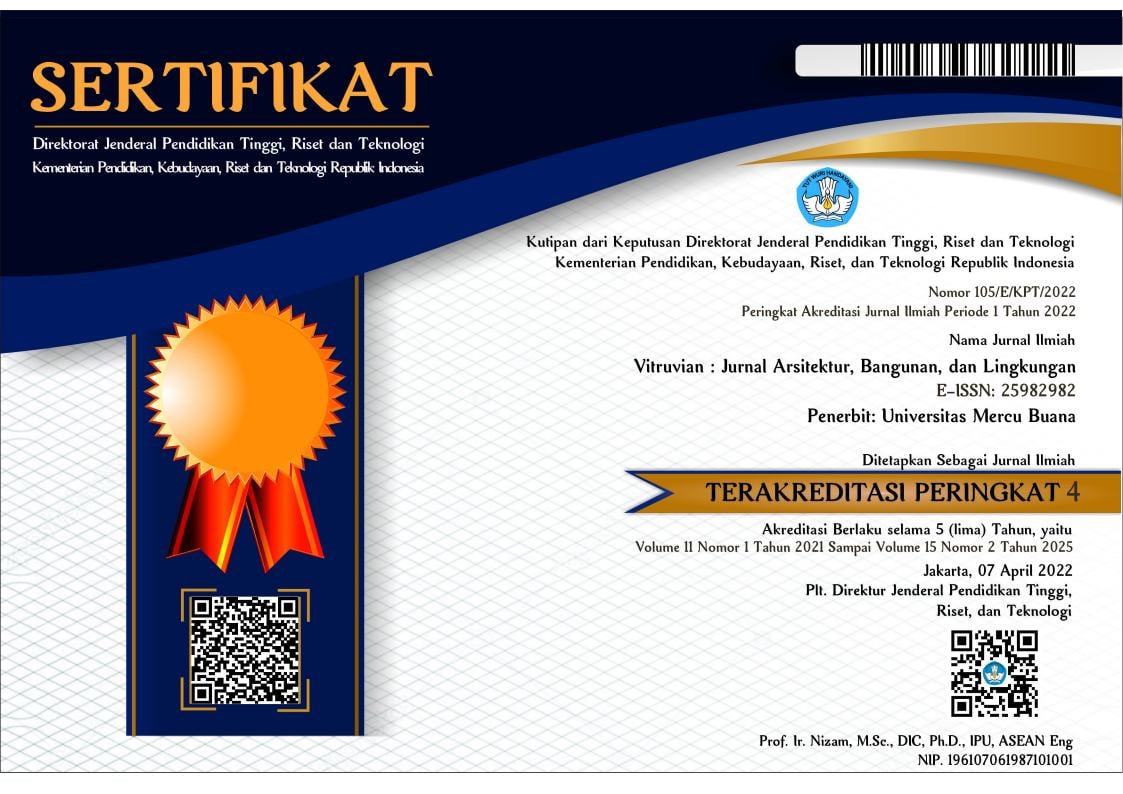PENERAPAN AURALISASI ARSITEKTUR DALAM IMPLEMENTASI PENGALAMAN AUDIO VISUAL RUANG DALAM: Review
Abstract
Perkembangan teknologi dalam simulasi akan mempengaruhi analisis kebutuhan ruangan akustik. Simulasi membantu memprediksi dan melihat fenomena akustik di ruang dalam ruangan. Seiring dengan kemajuan aplikasi, penggunaan auralisasi sering digunakan untuk menganalisis audio visual bangunan bersejarah, terutama melihat sistem akustik atau fenomena akustik yang terjadi di masa lalu. Simulasi dan Auralisasi Real-Time Interaktif sangat disarankan dan merupakan metode yang akurasinya sudah teruji terhadap ruangan yang dapat dimodifikasi sesuai dengan kebutuhan dari ruang tersebut. Auralisasi tidak hanya sebatas pada audio visual akan tetapi mulai menjadi salah satu alternatif untuk memprediksi kebutuhan akan persebaran audio pada masa mendatang. Ketika kinerja ruang tidak hanya dilihat dari satu aspek maka diperlukan auralisasi untuk menentukan kinerja apakah yang mempengaruhi ruang dalam. Penggunaan aplikasi berbasis auralisasi menjadi sangat menarik ketika ditemukan bahwa kinerja ruang dalam ditemukan fenomena baru yang mungkin jika diteliti secara nyata sulit untuk ditemukan. Pengukuran auralisasi tidak terbatas pada satu ruang, penonton, tetapi bangunan itu sendiri menjadi subjek penelitian menggunakan auralisasi. Kedepannya auralisasi tidak hanya terfokus pada aspek teknis, tetapi diharapkan dan dimungkinkan dapat diterapkan pada kajian lingkungan sosial. Perkembangan aplikasi berbasis auralisasi masih perlu dikembangkan terutama dari sisi penelitian social untuk melihat adanya representasi di area tertentu.
Technological developments in simulation influence the analysis of acoustic space requirements. Simulations help predict and confirm room acoustic phenomena. With the evolution of applications, the use of auralization is widely used to analyze the audiovisuals of historic buildings, especially with respect to sound systems or acoustic phenomena that occurred in the past. Real-time interactive simulation and auralization are highly recommended. This method has been tested for accuracy using rooms that can be modified according to room needs. Auralization is not limited to audiovisual media, but is slowly emerging as an alternative for anticipating future audio delivery needs. If room performance is not considered in one dimension, auralization is necessary to determine which performance influences the interior space. If internal performance turns out to be a new phenomenon that is elusive in practical investigations, the use of insonification-based applications will be of great interest. Auralization measurements are not limited to one space, the audience, but the building itself is the object of auralization research. In the future, it is expected and possible that auralization will not only focus on technical aspects, but that auralization can be applied to the study of social environments. The development of auditory-based applications has yet to be developed, especially with respect to social surveys to ascertain representations in specific domains.
Keywords
Full Text:
PDF (Bahasa Indonesia)References
Ahrens, J., & Andersson, C. (2019). Perceptual evaluation of headphone auralization of rooms captured with spherical microphone arrays with respect to spaciousness and timbre. The Journal of the Acoustical Society of …. https://doi.org/10.1121/1.5096164
Autio, H., Barbagallo, M., Ask, C., Bard Hagberg, D., Lindqvist Sandgren, E., & Strinnholm Lagergren, K. (2021). Historically Based Room Acoustic Analysis and Auralization of a Church in the 1470s. Applied Sciences, 11(4), 1586.
Berardi, U., & Iannace, G. (2020). The acoustic of Roman theatres in Southern Italy and some reflections for their modern uses. Applied Acoustics, 170, 107530.
Braasch, J., Chabot, S., Chertok, E., Jonathan, M., & Ellington Scott, E. K. (2021). Auralizing concert venues over extended listening areas using wave field synthesis. Audio Engineering Society Convention 150.
Brinkmann, F., Aspöck, L., Ackermann, D., Lepa, S., Vorländer, M., & Weinzierl, S. (2019). A round robin on room acoustical simulation and auralization. The Journal of the Acoustical Society of America, 145(4), 2746–2760.
Brinkmann, F., Aspöck, L., Ackermann, D., Opdam, R., Vorländer, M., & Weinzierl, S. (2021). A benchmark for room acoustical simulation. Concept and database. Applied Acoustics, 176, 107867.
Cabrera, D., Lee, D., Yadav, M., & Martens, W. L. (2011). Decay envelope manipulation of room impulse responses: Techniques for auralization and sonification. Proceedings of ACOUSTICS, 5.
Cairoli, M. (2020). Ancient shapes for modern architectural and acoustic design: Large interiors formed by curved surfaces. Applied Acoustics, 170, 107497.
Chen, Y., & Cabrera, D. (2021). The effect of concert hall color on preference and auditory perception. Applied Acoustics, 171, 107544.
Christian, A., Boyd Jr, D. D., Zawodny, N. S., & Rizzi, S. A. (2015). Auralization of tonal rotor noise components of a quadcopter flyover. INTER-NOISE and NOISE-CON Congress and Conference Proceedings, 250(3), 3983–3994.
Georgiou, F., de la Hosseraye, B. B., Hornikx, M., & Robinson, P. W. (2019). Design and simulation of a benchmark room for room acoustic auralizations. Universitätsbibliothek der RWTH Aachen.
Ivry, A., Cohen, I., & Berdugo, B. (2020). Evaluation of Deep-Learning-Based Voice Activity Detectors and Room Impulse Response Models in Reverberant Environments. ICASSP 2020-2020 IEEE International Conference on Acoustics, Speech and Signal Processing (ICASSP), 406–410.
Jiang, B., Xu, W., Ji, W., Kim, G., Pryor, M., & Sullivan, W. C. (2021). Impacts of nature and built acoustic-visual environments on human’s multidimensional mood states: A cross-continent experiment. Journal of Environmental Psychology, 77, 101659.
Kleiner, M., Dalenbäck, B.-I., & Svensson, P. (1993). Auralization-an overview. Journal of the Audio Engineering Society, 41(11), 861–875.
Maillard, J. (2016). Auralization applied to the evaluation of pedestrian and bike paths in urban environments. INTER-NOISE and NOISE-CON Congress and Conference Proceedings, 253(6), 2699–2708.
Mehra, R., Rungta, A., Golas, A., Lin, M., & Manocha, D. (2015). Wave: Interactive wave-based sound propagation for virtual environments. IEEE Transactions on Visualization and Computer Graphics, 21(4), 434–442.
Pelzer, S., Aspöck, L., Schröder, D., & Vorländer, M. (2014). Interactive real-time simulation and auralization for modifiable rooms. Building Acoustics, 21(1), 65–73.
Pike, C., & Romanov, M. (2017). An impulse response dataset for dynamic data-based auralization of advanced sound systems. Audio Engineering Society Convention 142.
Poirier-Quinot, D., Katz, B., & Noisternig, M. (2017). EVERTims: Open source framework for real-time auralization in architectural acoustics and virtual reality. 20th International Conference on Digital Audio Effects (DAFx-17).
Postma, B. N. J., & Katz, B. F. G. (2015). Creation and calibration method of acoustical models for historic virtual reality auralizations. Virtual Reality, 19(3), 161–180.
Postma, B. N. J., & Katz, B. F. G. (2016). Perceptive and objective evaluation of calibrated room acoustic simulation auralizations. The Journal of the Acoustical Society of America, 140(6), 4326–4337.
Savioja, L., & Xiang, N. (2019). Introduction to the special issue on room acoustic modeling and auralization. In The Journal of the Acoustical Society of America (Vol. 145, Issue 4, pp. 2597–2600). Acoustical Society of America.
Savioja, L., & Xiang, N. (2020). Simulation-based auralization of room acoustics. Acoust. Today, 16(4), 48–55.
Schröder, D. (2011). Physically based real-time auralization of interactive virtual environments (Vol. 11). Logos Verlag Berlin GmbH.
Thery, D., Boccara, V., & Katz, B. F. G. (2019). Auralization uses in acoustical design: A survey study of acoustical consultants. The Journal of the Acoustical Society of America, 145(6), 3446–3456.
Vorländer, M. (2020). Auralization. Springer.
Yang, W., & Moon, H. J. (2018a). Combined effects of sound and illuminance on indoor environmental perception. Applied Acoustics, 141, 136–143.
Yang, W., & Moon, H. J. (2018b). Cross-modal effects of illuminance and room temperature on indoor environmental perception. Building and Environment, 146, 280–288.
DOI: http://dx.doi.org/10.22441/vitruvian.2022.v12i2.004
Refbacks
- There are currently no refbacks.
Copyright (c) 2022 Vitruvian : Jurnal Arsitektur, Bangunan dan Lingkungan
License URL: https://publikasi.mercubuana.ac.id/index.php/virtuvian/editor/viewMetadata/17376
Layout Jurnal Vitruvian:Download
Declaration & CTA Form Vitruvian:Download
(WAJIB DI UPLOAD SEBAGAI SUPLEMENTARY SAAT SUBMIT ARTIKEL)
Vitruvian
Program Studi Arsitektur
Fakultas Teknik Universitas Mercu Buana
Jl. Raya Meruya Selatan, Kembangan, Jakarta 11650
Tlp./Fax : +62215871335
Surel : [email protected]
p-ISSN : 2088-8201
e-ISSN : 2598-2982
Website : http://publikasi.mercubuana.ac.id/index.php/virtuvian
DOI : 10.22441/vitruvian
Vitruvian is indexed by the following abstracting and indexing services:

This work is licensed under a Creative Commons Attribution-NonCommercial 4.0 International License.








